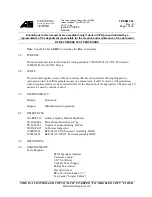
8.10 Configure Open Communication
n
Connection-oriented protocols establish a (logical) connection to the communication
partner before data transmission is started.
n
And if necessary they terminate the connection after the data transfer was finished.
n
Connection-oriented protocols are used for data transmission when reliable, guaran-
teed delivery is of particular importance.
n
In general, many logical connections can exist on one physical line.
The following connection-oriented protocols are supported with FBs for open communica-
tion via Industrial Ethernet:
n
TCP/IP native according to RFC 793 (connection types 01h and 11h):
–
During data transmission, no information about the length or about the start and
end of a message is transmitted.
–
The receiver has no means of detecting where one message ends in the data
stream and the next one begins.
–
The transfer is stream-oriented. For this reason, it is recommended that the data
length of the FBs is identical for the sending and receiving station.
–
If the number of received data does not fit to the preset length you either will get
not the whole data, or you will get data of the following job. The receive block
copies as many bytes into the receive area as you have specified as length. After
this, it will set NDR to TRUE and write RCVD_LEN with the value of LEN. With
each additional call, you will thus receive another block of sent data.
n
ISO on TCP according to RFC 1006:
–
During data transmission, information on the length and the end of the message
is also transmitted.
–
The transfer is block-oriented
–
If you have specified the length of the data to be received greater than the length
of the data to be sent, the receive block will copy the received data completely
into the receive range. After this, it will set NDR to TRUE and write RCVD_LEN
with the length of the sent data.
–
If you have specified the length of the data to be received less than the length of
the sent data, the receive block will not copy any data into the receive range but
instead will supply the following error information: ERROR = 1, STATUS = 8088h.
n
There is thus no establishment and termination of a connection with a remote partner.
n
Connection-less protocols transmit data with no acknowledge and with no reliable
guaranteed delivery to the remote partner.
The following connection-oriented protocol is supported with FBs for open communication
via Industrial Ethernet:
n
UDP according to RFC 768 (with connection type 13h):
–
In this case, when calling the sending block you have to specify the address
parameters of the receiver (IP address and port number).
–
During data transmission, information on the length and the end of the message
is also transmitted.
–
In order to be able to use the sending and receiving blocks first you have to con-
figure the local communications access point at both sides.
–
With each new call of the sending block, you re-reference the remote partner by
specifying its IP address and its port number.
–
If you have specified the length of the data to be received greater than the length
of the data to be sent, the receive block will copy the received data completely
into the receive range. After this, it will set NDR to TRUE and write RCVD_LEN
with the length of the sent data.
–
If you have specified the length of the data to be received less than the length of
the sent data, the receive block will not copy any data into the receive range but
instead will supply the following error information: ERROR = 1, STATUS = 8088h.
Connection-oriented pro-
tocols
Connection-less protocol
System 300S
+
Deployment Ethernet communication - productive
Configure Open Communication
HB140 | CPU | 315-4PN23 | en | 18-02
116
Содержание SPEED7 300S+ CPU 315PN
Страница 1: ...CPU 315 4PN23 Manual HB140 CPU 315 4PN23 en 18 02 System 300S SPEED7 CPU 315PN...
Страница 89: ...System 300S Deployment PtP communication Modbus Example communication HB140 CPU 315 4PN23 en 18 02 89...
Страница 155: ...Appendix System 300S Appendix HB140 CPU 315 4PN23 en 18 02 155...
















































